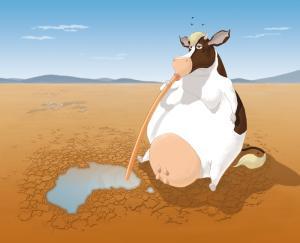 Water, water nowhere, with little left to drink.
Water, water nowhere, with little left to drink.
—
Australians are superlative natural resource wasters, but living in the driest inhabited continent on the planet, you’d think we’d be precious about our water use.
You’d be wrong.
On the contrary, Australia has a huge water footprint (defined as “the total volume of freshwater that is used to produce the goods and services consumed by the people of the nation”). For internal domestic use (i.e., not including agricultural and industrial uses, or water imported directly or within other goods), Australians use about 341,000 litres per person per year (data from 1997–2001), which is six times the global average of 57,000 litres per person per year (1).
Agricultural production is one of the chief consumers of freshwater around the world. For example, the global average virtual water content of rice (paddy) is 2.29 million litres/tonne produced, and for wheat it is 1.33 litres/tonne. Growing crops for biofuel in particular has a huge water footprint—depending on the crop in question, it takes an average of 1,400–20,000 litres of water to produce just one litre of biofuel (2). If an agricultural product comes from livestock — say, meat, leather, or wool — the water content is typically much higher because of the feed required to keep the animal alive. For example, it takes about three years to raise beef cattle to slaughtering age, with an average of 200 kg of boneless beef produced per animal. This requires about 1,300 kg of grains, 7200 kg of pasture or hay, and 31000 litres of water for drinking and cleaning. This means that the total amount of water required to produce 1 kg of beef is about 15340 litres (1). For Australia, which has over 20 million or so cattle at any one moment, the water footprint alone should at least be cause for concern the next time you tuck into a steak dinner.
Australia’s lust for deforestation and irrigation means that even the little water we have left is becoming useless, and it is destroying our already depleted soils even more. The rapid and expansive clearing of Australia’s forests brutally upset the delicate water balance in the soils of our ancient landscape. Much of inland Australia has been inundated by seawater at various times over the last several hundred million years, a product of plate tectonics and large shifts in global temperatures leading to impressive sea-level changes that periodically flooded our relatively low-altitude landscape. Additionally, oceanic winds carrying sea salt have transported huge quantities of salt to the land, and the erosion of salt-bearing parent rocks over millions of years all mean that Australian soils have an unusually high salt content. When the land is disturbed and irrigated over large areas, salt migrates to the surface, effectively poisoning the soil for plant growth. Widespread throughout Australia now, this salinity problem affects well over 3 million hectares of arable land in the south, with the majority of that area in Western Australia and New South Wales. The economic implications are measured in the billions of dollars of lost agricultural opportunity, with the prospect of much more area of saline deserts forming in Australia’s arable lands over the coming decades.
What are our options then? Eating more vegetarian meals, stopping all deforestation, and reforesting large areas of marginal agricultural land are good places to start.
CJA Bradshaw
References
- Hoekstra & Chapagain. 2007. Water footprints of nations: water use by people as a function of their consumption pattern. Water Resour Manage 21: 35-48
- Gerbens-Leenes et al. 2009. The water footprint of bioenergy. P Natl Acad Sci USA 106:10219-10223

